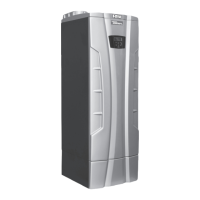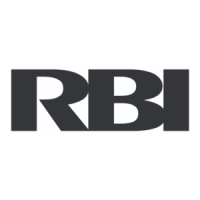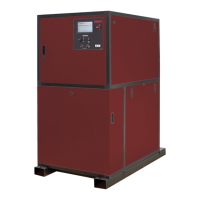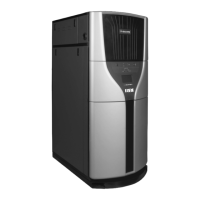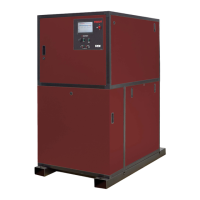nne
co
er tu
e gas
o
ers
water
eaters –
o
er
anua
30
CHECKING & ADJUSTMENTS
1. With the burners in operation, close the manual shuto valve in
the gas supply line. As soon as the main burner ames go out,
open the manual shuto valve. A normal ignition sequence should
take place. If the burners fail to light, the gas valves will close and
the system will go into a 5-minute lock out period. e ignition
module will then make a second ignition a empt. If the unit won't
light ensure that the gas piping is fully purged of air. Inspect the
ignition system and ensure that it is operating properly.
2. To test the ignition safety shuto device, close the manual shuto
valve in the gas supply line. Within 5 seconds of main burner
ame extinction, the main gas valve solenoid should close with
an audible noise. e pilot light on the display board should be lit
while the ignition module tries to relight the pilot. A er 10
seconds the module should lockout and the trial for ignition end.
A er 5 minutes a second trial for ignition should occur. Open the
manual shuto valve in the gas supply line and reset the ignition
control system. A normal ignition sequence should take place.
3.
With the burners in operation, interrupt the power to the control
circuit by reducing the target temperature of the staging controller
or turning down the thermostat. e boiler/water heater should
stage down and shut down. Reset the operating control or thermo-
stat. A normal ignition sequence should follow.
Input Rate, Natural Gas
Gas appliances are rated based on sea level operation with no
adjustment required at elevations up to 5000 , 1524 m. At elevations
above 5000 , 1524 m, input ratings should be reduced by 4% for
each additional 1000 , 305 m.
Check the input rate as follows:
1. Turn o all other gas appliances that use the same gas meter as
the boiler/water heater.
2. Call your gas supplier and ask for the heating value of the gas.
3. Connect a ue gas analyzer to the vent pipe.
4. Start the boiler/water heater and let it run for 15 minutes.
5. Using the gas meter and a stopwatch, clock the time that it takes
to burn 10
3
, 0.28 m
3
of gas and divide this time by 10.
6. Insert the heating value and the time, in seconds, into the formula
below.
7.
Input = (heating value, Btu/hr)(3600)/(time, seconds)
8. If the computed rate deviates by more than 5% from the rated
input value of the unit adjust the manifold pressure accordingly.
DO NOT adjust the manifold pressure by more than 5%. If a
proper rate cannot be maintained without adjusting the manifold
pressure beyond the 5% limit, the main burner ori ces must be
replaced. If the input rate is too low, go to the next larger size of
main burner ori ces. If the input rate is too high, go to the next
smaller size.
9. At full input the CO
2
should be between 7.5% and 8.5%
with a CO reading of less than 50 ppm. See Table 20.
Never increase the input of the boiler/water heater
above that for which it is rated. Doing so can cause
premature failure of the unit!
Pilot Adjustment
e pilot burner is actually an isolated main burner that
stages with the other burners. It is controlled by a separate pilot
valve. Pilot pressure se ings are as shown in Table 19. ese pressures
are measured at the pilot pressure valve, see Figure 19. See Tables
12 and 13 to determine the ring mode that is associated with each
stage.
To view the pilot without main burner operation, take the following
steps:
For D300-D400:
1. Remove the upper front jacket panel.
2. Turn o main burner gas ow by turning the main burner gas
valve knob to the o position, Figure 18.
3. Observe the pilot ame through the observation port located
at the le end of the unit.
For D600-D2100:
1. Remove the upper front jacket panel.
2. Turn o main burner gas ow by turning the manual gas valve(s)
in the control compartment to the o position, see Figure 19.
3. Observe the pilot ame through the observation port located
at the le end of the unit.
Pilot pressures will be set at the factory. However, if it is necessary
to adjust the pilot pressure to match those in Table 19, take the
following steps:
1. Remove the upper front jacket panel.
2. Remove the 1/8" plug from the pilot pressure test port and
connect a 20 in, 508 mm W.C. manometer to it, see Figure 18.
3. Remove the gas pressure regulator cap from the pilot valve. See
Figure 18 for the location of the regulator and cap.
4. Use a 3/32 hex wrench to turn the pressure regulator adjustment
screw clockwise to increase the pilot pressure and counterclockwise
to decrease it.
5. Replace the pressure regulator adjustment screw cap.
Gas Pressure Adjustment
e maximum inlet gas pressure listed on the rating
plate must not be exceeded or damage to the boiler/
water heater may occur voiding the warranty!
e minimum supply pressure listed on the rating plate is for input
adjustment.

